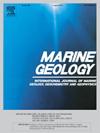Modern bioturbation structures and their mixing effects in the Yangtze River Estuary and its adjacent sea areas
IF 2.2
3区 地球科学
Q2 GEOSCIENCES, MULTIDISCIPLINARY
引用次数: 0
Abstract
Bioturbation structures are not only critical indicators to the state of the seafloor environment but also serve as important proxies for reconstructing paleo-environments. Furthermore, bioturbation processes will cause the redistribution of materials and early diagenesis in sediments, which makes it a challenging component to explore elements cycles or interpret sedimentary records over centennial time scale. This study, based on sediment cores from 31 stations in the Yangtze River Estuary and its adjacent areas, utilized high-resolution X-ray computed tomography (CT) scanning technology and MATLAB data processing method, along with measurements of sediment grain size and 210Pb activity, to qualitatively and quantitatively characterize the bioturbation structures in the area and estimate mixing intensity. The results indicate that bioturbation structures can be functionally categorized into four types: biodiffusor structure, conveyors structure, regenerator structure and gallery-diffusor structure, with conveyors structure and gallery-diffusor structure being the most common. The vertical distribution patterns of bioturbation structures within the cores exhibit variations, including exponential decay pattern, fluctuating decay pattern, pulse distribution pattern, and uniform distribution pattern. Based on bioturbation intensity and their combinations, three bioturbation structural zones were identified: the Yangtze River Estuary bioturbation zone, the coastal sand ridge and northern Zhejiang-Fujian bioturbation zone, and the transitional phase and northern Zhejiang-Fujian muddy bioturbation zone. The mixing coefficients in this area ranges from 0.02 to 884.24 cm2/yr, exhibiting significant spatial variation. Strong mixing is observed in the pro-delta and delta front-shelf transition zones, while weaker mixing occurs in the northern Zhejiang-Fujian muddy area and the southern coastal region of northern Jiangsu coastal. The mixing effects are influenced not only by bioturbation but also by non-biological factors such as physical mixing.
长江口及邻近海域现代生物扰动结构及其混合效应
生物扰动结构是反映海底环境状况的重要指标,也是重建古环境的重要指标。此外,生物扰动过程将导致沉积物中物质的再分配和早期成岩作用,这使得探索元素旋回或解释百年时间尺度的沉积记录成为一个具有挑战性的组成部分。本研究基于长江口及邻区31个测站的沉积物岩心,利用高分辨率x射线计算机断层扫描(CT)技术和MATLAB数据处理方法,结合沉积物粒度和210Pb活度测量,对该区域的生物扰动结构进行了定性和定量表征,并估算了混合强度。结果表明,生物扰动结构在功能上可分为生物扩散器结构、传送带结构、再生器结构和廊道-扩散器结构四种类型,其中以传送带结构和廊道-扩散器结构最为常见。岩心内生物扰动结构的垂直分布模式呈现指数衰减模式、波动衰减模式、脉冲分布模式和均匀分布模式。根据生物扰动强度及其组合,划分出3个生物扰动构造带:长江口生物扰动带、滨海沙脊和浙闽北部生物扰动带、过渡期和浙闽北部浑浊生物扰动带。混合系数在0.02 ~ 884.24 cm2/yr之间,具有显著的空间差异。前三角洲和三角洲前陆架过渡带的混合作用较强,而浙闽泥质北部和苏北沿海南部地区混合作用较弱。混合效果不仅受到生物扰动的影响,还受到物理混合等非生物因素的影响。
本文章由计算机程序翻译,如有差异,请以英文原文为准。
求助全文
约1分钟内获得全文
求助全文
来源期刊

Marine Geology
地学-地球科学综合
CiteScore
6.10
自引率
6.90%
发文量
175
审稿时长
21.9 weeks
期刊介绍:
Marine Geology is the premier international journal on marine geological processes in the broadest sense. We seek papers that are comprehensive, interdisciplinary and synthetic that will be lasting contributions to the field. Although most papers are based on regional studies, they must demonstrate new findings of international significance. We accept papers on subjects as diverse as seafloor hydrothermal systems, beach dynamics, early diagenesis, microbiological studies in sediments, palaeoclimate studies and geophysical studies of the seabed. We encourage papers that address emerging new fields, for example the influence of anthropogenic processes on coastal/marine geology and coastal/marine geoarchaeology. We insist that the papers are concerned with the marine realm and that they deal with geology: with rocks, sediments, and physical and chemical processes affecting them. Papers should address scientific hypotheses: highly descriptive data compilations or papers that deal only with marine management and risk assessment should be submitted to other journals. Papers on laboratory or modelling studies must demonstrate direct relevance to marine processes or deposits. The primary criteria for acceptance of papers is that the science is of high quality, novel, significant, and of broad international interest.
 求助内容:
求助内容: 应助结果提醒方式:
应助结果提醒方式:


